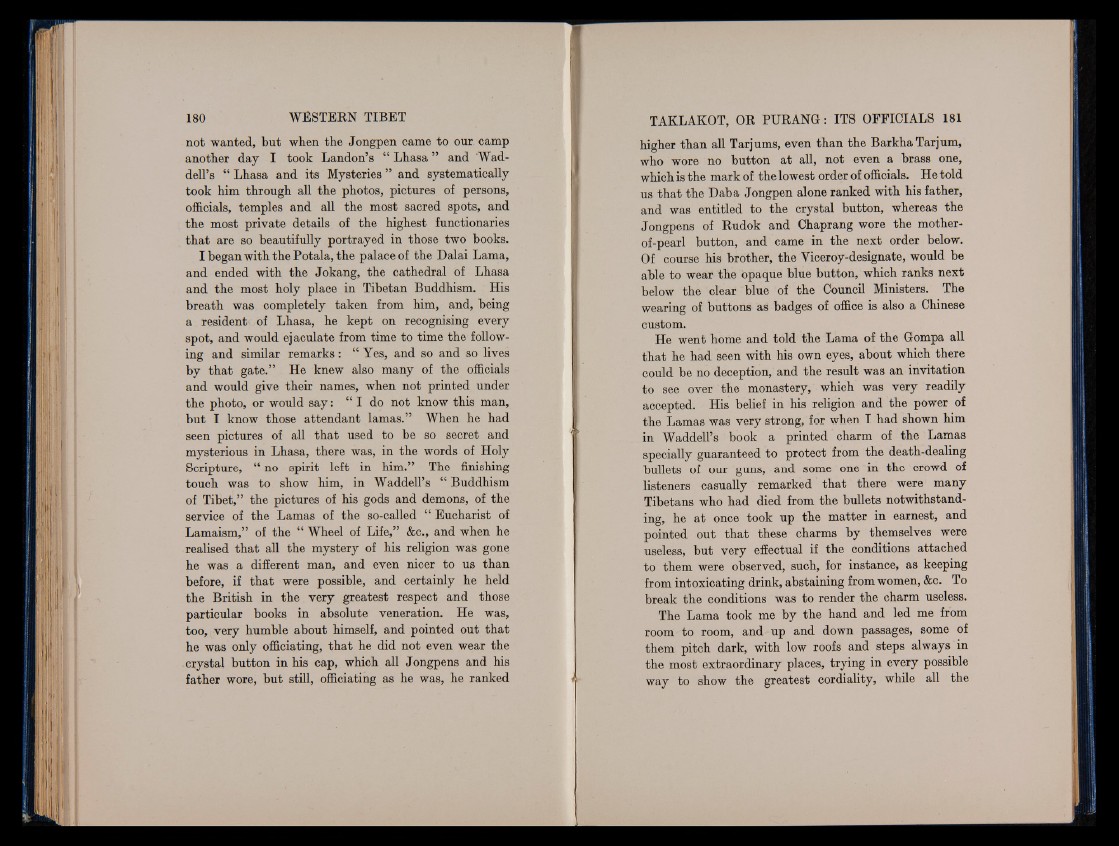
not wanted, but when tbe Jongpen came to our camp
another day I took Landon’s “ Lhasa ” and Waddell’s
“ Lhasa and its Mysteries ” and systematically
took him through all the photos, pictures of persons,
officials, temples and all the most sacred spots, and
the most private details of the highest functionaries
that are so beautifully portrayed in those two books.
I began with the Potala, the palace of the Dalai Lama,
and ended with the Jokang, the cathedral of Lhasa
and the most holy place in Tibetan Buddhism. His
breath was completely taken from him, and, being
a resident of Lhasa, he kept on recognising every
spot, and would ejaculate from time to time the following
and similar remarks: “ Yes, and so and so lives
by that gate.” He knew also many of the officials
and would give their names, when not printed under
the photo, or would say: “ I do not know this man,
but I know those attendant lamas.” When he had
seen pictures of all that used to be so secret and
mysterious in Lhasa, there was, in the words of Holy
Scripture, “ no spirit left in him.” The finishing
touch was to show him, in Waddell’s “ Buddhism
of Tibet,” the pictures of his gods and demons, of the
service of the Lamas of the so-called “ Eucharist of
Lamaism,” of the “ Wheel of Life,” &c., and when he
realised that all the mystery of his religion was gone
he was a different man, and even nicer to us than
before, if that were possible, and certainly he held
the British in the very greatest respect and those
particular books in absolute veneration. He was,
too, very humble about himself, and pointed out that
he was only officiating, that he did not even wear the
crystal button in his cap, which all Jongpens and his
father wore, but still, officiating as he was, he ranked
higher than all Tarjums, even than the Barkha Tarjum,
who wore no button at all, not even a brass one,
which is the mark of the lowest order of officials. He told
us that the Daba Jongpen alone ranked with his father,
and was entitled to the crystal button, whereas the
Jongpens of Rudok and Chaprang wore the mother-
of-pearl button, and came in the next order below.
Of course his brother, the Viceroy-designate, would be
able to wear the opaque blue button, which ranks next
below the clear blue of the Council Ministers. The
wearing of buttons as badges of office is also a Chinese
custom.
He went home and told the Lama of the Gompa all
that he had seen with his own eyes, about which there
could be no deception, and the result was an invitation
to see over the monastery, which was very readily
accepted. His belief in his religion and the power of
the Lamas was very strong, for when I had shown him
in Waddell’s book a printed charm of the Lamas
specially guaranteed to protect from the death-dealing
bullets of our guns, and some one in the crowd of
listeners casually remarked that there were many
Tibetans who had died from the bullets notwithstanding,
he at once took up the matter in earnest, and
pointed out that these charms by themselves were
useless, but very effectual if the conditions attached
to them were observed, such, for instance, as keeping
from intoxicating drink, abstaining from women, &c. To
break the conditions was to render the charm useless.
The Lama took me by the hand and led me from
room to room, and up and down passages, some of
them pitch dark, with low roofs and steps always in
the most extraordinary places, trying in every possible
way to show the greatest cordiality, while all the